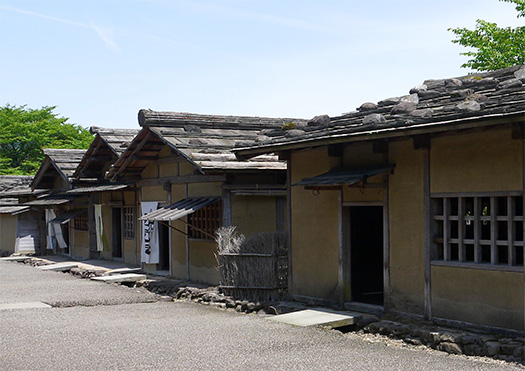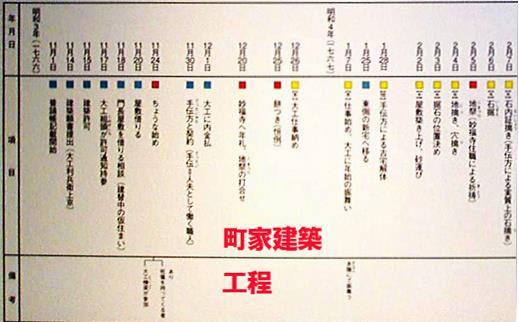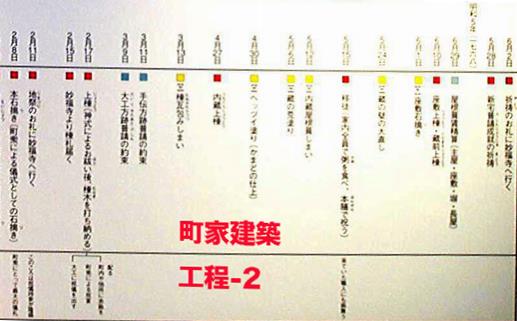


ムラ共同体での家づくりと、都市部町家の家づくりの相違ポイントを
残っている普請帳記録から探ってみております。町家の後編。
歴史とは端的に経済支配によって権力が成立し続けてきた。
最初期権力は田畑の支配がその基本的性格だったのだろうと思います。
定住と農耕・牧畜などの産業支配が権力発生の動因。
そういう段階から徐々に商業・流通といった領域が勃興した。
日本史では平氏政権は宋銭の導入で重商主義的政権だったと言われる。
ただ、重商主義的政権は安定せず長続きしないことから
徳川政権でも初期はかなり手厚い商業重視政策というか、
江戸の都市発展という公共事業を盛んに行ってきた。しかしその後
幕府財政の逼迫と共に、ひたすら重農的な管理強化に向かっていった。
信長政権は「楽市楽座」というカタチでそれまでの寺社から
利権を奪取する重商主義政策を取り、秀吉政権もそれを継承発展させた。
信長が中世的桎梏、比叡山寺社権力を焼き討ちしたのには
商業政策の大革新を果たすため中世商業利権勢力である寺社影響力一掃が
その大きな目的だったのだと思います。
現代にまで「寺銭」という言葉が残るようにこれは根深いものだった。
信長は将軍を擁立して京都を制圧した実績への報償として
「副将軍」職として処遇されようとしたとき、それを辞退して
国際商業都市・堺に代官を置いて支配する許可に代えさせていますね。
かれの意思が既成権力機構ポストではなくビジネス的実利にあった証明。
おっと、前振り長すぎ(笑)。
さて、きのうからの続きで大阪府柏原市の三田家住宅の普請帳から。
いまから255年ほど前の町家建築ですが、ムラの共同体的家づくりと違って
貨幣経済の浸透が当然の前提になって建築は現代とそう変わらない形態。
建て替え工事だったようで仮住まいへの家移りから普請帳に記載。
1766年11月20日には仮住まいの屋敷を借上。
11月24日に「ちょうな始め」記載。これは家の建築に際し大工が
仕事を始める日に行う儀礼とされている。着工ですね。
11月30日に手伝方(人夫)と契約。翌12月1日に大工へ内金払い。
そこから年末年始の休暇を挟んで工事が続いている。
基礎工事が終わっていないので仕口手刻みなど
あとは組み上げるだけ段階までの構造各部材仕上げが進行と推定。
1月25日に「新宅へ移る」とあるので、主屋以外の建物が先行し
そちらに仮住まい先を変えたかと推測される。
1月28日に「古宅解体」されて2月2日に「屋敷焚き上げ」とある。
ムラの建築では「古材」をかなり使って節約に努めます、みたいな
建築確認申請書類の記述があったけれど、こちらでは
材料はまったく更新されて新材ばかりで建てられたようです。
翌3日に礎石の場所決めを行い地突き・穴突きという基礎工事。
2月5日「地祭」という地鎮祭とおぼしき儀礼が行われる。
で12日後2月17日上棟式が行われているので推測通り各部材づくりが先行し、
この日に木造軸組架構が組み上げられたと思われる。お寺からは棟札到着。
その後20日ほどで「大工方跡普請」「手伝い方跡普請」の約束を交わしている。
これは先の「内金」との対応で中間金もしくは精算金規定、支払方法確定、
と言うような意味合いの記述かと思われる。
その後も屋根葺きや別棟の蔵の建築造作などが進行し4月30日には
「へっつい(かまど)塗り」とあって食事支度も可能になって
5月15日に移住となっている。「家族全員で粥を食べ本膳で祝う」。
そして5月28日に新宅普請成就の祈祷、6月2日無事完了の報告に社寺訪問。
おおむね7ヶ月の建て替え新築工事が終了となっている。
都市部の住宅では250年以上前から現代の家づくりとほぼ同様工程で
建築確認申請プロセスもあって、契約関係も
現代と似通った家づくりが進行していた実態が理解出来ますね。
<写真は越前一乗谷復元町家。本文とは無関係>
English version⬇
[Urban housing Machiya house building (after) / Japanese good house ㉘-4]
Differences between building a house in the Mura community and building a house in an urban townhouse
I am searching from the remaining records of the general contract book. The second part of Machiya.
In history, power has continued to be established by economic control.
I think that the rule of Tabata was the basic character of the earliest power.
Settlement and industrial control such as farming and livestock farming are the motives for the generation of power.
From that stage, areas such as commerce and distribution gradually emerged.
In Japanese history, the Taira administration is said to have been a mercantilist administration with the introduction of the Southern Song dynasty.
However, because the mercantilist government is not stable and does not last long.
Even in the Tokugawa administration, it is a fairly generous commercial-oriented policy at the beginning,
We have been actively engaged in public works projects called urban development in Edo. But then
Along with the tight financial situation of the Shogunate government, we headed toward strengthening Physiocratic management.
The Nobunaga administration took the form of “Rakuichi Rakuza” from the temples and shrines up to that point.
It took a mercantilist policy to seize interests, and the Hideyoshi administration inherited and developed it.
Nobunaga burned down the power of the medieval siege of Mount Hiei
Elimination of the influence of temples and shrines, which are medieval commercial concessions, to achieve a major innovation in commercial policy
I think that was the big purpose.
This was so deep-rooted that the word “temple money” remained until today.
Nobunaga was in return for his achievements in conquering Kyoto by supporting the shogun.
When he tried to be treated as a “deputy general”, he declined it
He has a substitute for permission to control Sakai, an international commercial city.
Proof that his intention was in business interest, not in the established power organization post.
Oops, it’s too long to swing forward (laughs).
By the way, continuing from yesterday, from the general contract book of the Mita family residence in Kashiwara City, Osaka Prefecture.
It is a townhouse building about 255 years ago, but unlike Mura’s community house building.
Architecture is a form that is not so different from modern times, with the permeation of the monetary economy as a natural premise.
It seems that it was a rebuilding work, so it was recorded in the general contract book after moving to a temporary residence.
On November 20, 1766, he rented a temporary residence.
Described as “Chona Hajime” on November 24th. This is a carpenter when building a house
It is said to be a ritual performed on the day of starting work. It’s the start of construction.
Contracted with a helper (labor) on November 30th. The next day, December 1st, the carpenter was paid a deposit.
From there, construction continues with the year-end and New Year holidays in between.
Since the foundation work has not been completed, hand-carved joints, etc.
After that, it is estimated that the finishing of each structural member up to the stage of assembling is in progress.
Since it says “to move to a new house” on January 25, buildings other than the main building will precede.
It is presumed that the temporary residence was changed there.
It is said that the old house was dismantled on January 28th and that the mansion was fired on February 2nd.
In Mura’s architecture, we try to save money by using a lot of “old materials”.
There was a description of the building confirmation application documents, but here
It seems that the materials have been completely renewed and built with only new materials.
The next day, the 3rd, the location of the cornerstone was decided, and the foundation work called ground thrusting and hole thrusting.
On February 5th, a ritual called “jichinsai” will be held.
Twelve days later, on February 17, the topping-out ceremony was held, so as expected, each member was made first.
It seems that the wooden frame frame was assembled on this day. The building tag arrived from the temple.
About 20 days after that, he made a promise of “carpenter traces” and “helping traces”.
This is in correspondence with the previous “inside payment”, intermediate payment or settlement payment regulation, payment method confirmed,
It seems that it is a description of the meaning.
After that, roofing and architectural construction of the annex warehouse continued to progress, and on April 30th.
It is possible to prepare meals because it says “Kamado coating”.
It has been relocated on May 15th. “The whole family eats porridge and celebrates with Honzen.”
Then, on May 28, he prayed for the fulfillment of the new house, and on June 2, he visited the shrines and temples to report the successful completion.
Approximately 7 months of rebuilding and new construction work has been completed.
For urban housing, the process is almost the same as modern home building for more than 250 years.
There is also a building confirmation application process, and there is also a contractual relationship
You can understand the fact that house building similar to the present age was in progress.
Posted on 4月 16th, 2021 by 三木 奎吾
Filed under: 住宅マーケティング, 日本社会・文化研究







コメントを投稿
「※誹謗中傷や、悪意のある書き込み、営利目的などのコメントを防ぐために、投稿された全てのコメントは一時的に保留されますのでご了承ください。」
You must be logged in to post a comment.